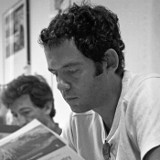











how to build a curved shape out of flat panels
The FlexMaps Pavilion is 4x4 meters of CNC-milled plywood structure, carved with a computationally designed spiraling pattern. This pattern aims at controlling the flexibility of each panel so that, once all pieces are individually bent and assembled, the structure reaches the designed target shape.
The FlexMaps Pavilion has been awarded First Prize at the Competition and Exhibition of innovative lightweight structures organized by the IASS Working Group 21 within the FORM and FORCE, joint international conference of IASS Symposium 2019 and Structural Membranes 2019 with the following motivation:
for its structural innovation of bending-twisting system, connection constructability and exquisite craftmanship
| 337 | Spirals |
| 75 | Flat panels |
| 58 | Paving tiles |
| 2 | Base supports |
| 816 | Bolts |
| 620 | Connectors |
| 95 | Kg |
| 3 | Boxes |

















18-20 October 2019 - https://2019.makerfairerome.eu/en/exhibitors/?ids=933











7-11 October 2019 - https://www.jjo33.com/iass-barcelona-2019













The design pipeline starts from a quadbased mesh, which defines the edge size and the total amount of spirals. Each spiral is embedded within a quad. Then, a physically-based optimization algorithm tunes the geometry of the spirals by using a simplified rod model whose mechanical parameters are interpolated from a pre-computed database of examples. Each example has been calibrated to match the behavior of an non-linear FEM simulation of an individual spiral subject to hundreds of load combinations.
The FlexMaps Pavilion is a bending-active single-layer piecewise non-developable twisted arc, which fits a bounding box of 3.90x4.00x3.25 meters and allows the visitors to go through it. The stiffness of the panels, called FlexMaps, is controlled by spiraling geometric mesostructures, which are computationally optimized in both size and shape to match the curvature of the target shape locally. As a result, various mechanical properties are obtained only by acting on geometric parameters. While commonly bending-active structures need rotational degrees of freedom in the assembly phase (i.e. hinged edges or pinned joints) or inflation loading, in the FlexMaps Pavilion each panel lays flat in the rest configuration and its final shape results from internal elastic forces that arise when connecting progressively the patches together. Apart from achieving a design-efficient solution and an aesthetically-pleasant organic appearance, the FlexMaps Pavilion allows easy fabrication and assembly procedures.
Limited bending energy is required to join the component reciprocally. 2D FlexMaps panels are fabricated by CNC-cut 20-mm plywood panels. The segmented pattern is user-defined to fit within 3 boxes. The ground edges are clamped in a plywood base. The free-edges that form two crossed arches are stiffened using segmented 6-mm plywood plates, providing additional restraint to the panels. FlexMaps connectors are encoded within the computational framework and are made of interlocking shapes, additionally secured by screws.

Manifattura Circolare CNC service
Paolo Cignoni paolo.cignoni@isti.cnr.it

Francesco Laccone

Luigi Malomo

Jesús Pérez (IST Austria)

Nico Pietroni

Alessandro Muntoni

Thomas Alderighi

Federico Ponchio

Bernd Bickel (IST Austria)

Paolo Cignoni
Visual Computing Lab Staff ISTI - CNR, in particular Marco Callieri, Paolo Pingi for helping multiple times to tirelessly assemble and disassemble the pavilion.
Antonio Rizzo, IPCF - CNR for providing the space where test the structure.
Administrative Staff ISTI - CNR for helping us to find and buy the needed material and services.